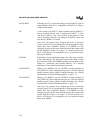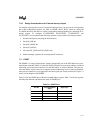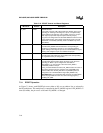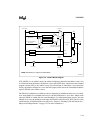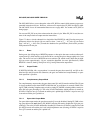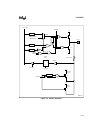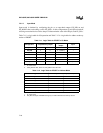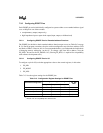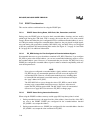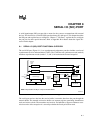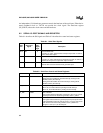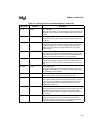
7-18
8XC196NP, 80C196NU USER’S MANUAL
7.3.3 EPORT Considerations
This section outlines considerations for using the EPORT pins.
7.3.3.1 EPORT Status During Reset, CCB Fetch, Idle, Powerdown, and Hold
During reset, the EPORT pins are forced to their extended-address functions and are weakly
pulled high. During the CCB fetch, FFH is strongly driven onto the pins. This value remains
strongly driven until either the pin is configured for I/O or a different extended address is access-
ed. If the pins remain configured as extended-address functions, they are placed in a high-imped-
ance state during idle, powerdown, standby (80C196NU only), and hold. If they are configured
as I/O, they retain their I/O function during those modes. See Figure 11-7 on page 11-8 and Table
B-5 on page B-13 for additional information.
7.3.3.2 EP_REG Settings for Pins Configured as Extended-address Signals
Nonextended data accesses go to the address contained in EP_REG. Therefore, if you configure
EP_REG to point to the desired address, you can use nonextended addressing modes to access
the extended address space. However, we recommend that you clear the EP_REG bits for any
EPORT pins configured as extended-address signals in order to maintain compatibility with soft-
ware development tools.
NOTE
If any pins are configured as extended-address signals and their corresponding
EP_REG bits are set, nonextended operations will still access the register file
and standard SFRs. However, all other nonextended accesses, including those
to internal RAM and internal nonvolatile memory, will be directed off-chip to
the “page” address in EP_REG.
The 8XC196NP allows you to change the value of EP_REG to control which
memory page a nonextended instruction accesses. However, software tools
require that EP_REG be equal to 00H. The 80C196NU forces all nonextended
data accesses to page 00H. You cannot use EP_REG to change pages.
7.3.3.3 EPORT Status During Instruction Execution
When using the EPORT to address memory outside page 00H, keep these points in mind:
1. During extended accesses, the upper four bits of the address (lower four bits of the EPC)
are sent to the EPORT. EPORT pins configured for the extended-address function
(EP_MODE.x set) output this address.
2. During nonextended accesses, EPORT pins configured for the extended-address function
(EP_MODE.x set) output the value contained in EP_REG.



